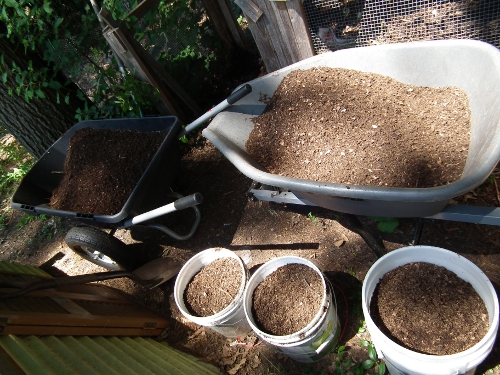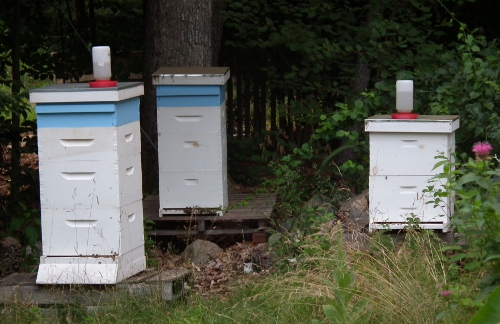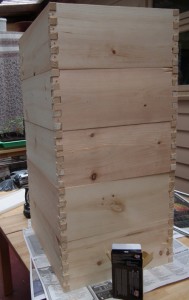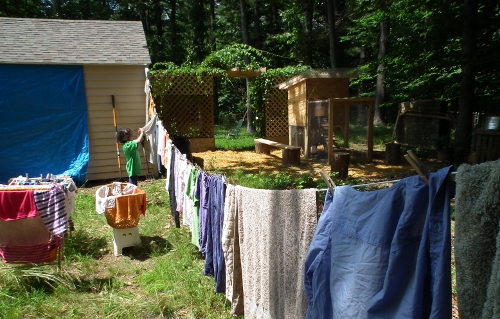Always a first.
Compost!
Blow Your Mind on a Muffin
Browsing through old photos I found this one, from December last year. We got the muffin on the plane to Belgium.
Notice how only the wholesome ingredients are circled and then the word “natural”. It was supposed to be a muffin,  though by my definition it was a pharmaceutical factory, or any number of other things that I wouldn’t even waste breath on. Not “Mmm…” And not “food,” which is what I categorized this under.
Riot for Austerity – June 2012 – Month 44
Here it is, the Riot for the month of June of 2012 for the three of us. My summary of our first three years is here. Edson fixed the calculator: all go tither to crunch those numbers!
Gasoline. Â Calculated per person.
16.35 gallons per person
39.8 % of the US National Average
Electricity. This is reckoned per household, not per person. We cook on an electric stove. According to our solar meter, we produced 4437 kWh since the system was turned on, and 581 kWh this last month (you can follow our solar harvest live here). And most heavy electrical  equipment has been turned off: the growing lights and heat mat and the heat lamps for our chicks. Result: we owed NStar nothing. How much we consumed is a mystery: our NSTAR bill will not say. All we know is that we produced 581 kWh and they rebated us (yes, paid us) $26, but who knows at what rate! I’m going to guess here:
380 KwH
21% of the US National Average
Heating Oil and Warm Water. This too is calculated for the entire household, not per person.
6.5 Â gallons of oil
10.5% of the US National Average
Trash. After recycling and composting this usually comes down to mainly food wrappers.
6 lbs. pp per month
4.4%Â of the US National Average
Water. This is calculated per person.
436 gallons pp.
14.5 %Â of the US National Average
Honey!
Yesterday I put the newly made honey supers (painted blue) onto the hives. Right on time for the one in the middle (H3): the honey super already on it (third box) was filled, frame to frame, inch for inch. Some of the outer frames just needed capping, so I left it for a couple more days. Then I’ll finally have honey, 60 pounds of it!
Solar Surplus Countdown!
We figured we need to overproduce (produce more than we consume) about 100 solar KwH by August 13th, which will be a year from when our solar system was connected to the grid and we started producing. If we make it, we’ll have broken even. It will be a challenge, since as of next week our household will double in size. There will be six of us: DH’s parents and sister will be with us for the summer. But they’appreciate the challenge, I’m sure.
I’m working on a plug-in for the blog that will track the race.
Speaking of Solar Surplus and Countdown…
Here in Wayland we are running the Solarize Massachusetts program. This is a state-sponsored program developed by the Massachusetts Clean Energy Center (MA CEC) and the Massachusetts Department of Energy Resources (MA DOER) to encourage residential solar photovoltaic electricity (PV) installations.  It provides a framework for municipalities, homeowners and solar installers to work collaboratively to maximize cost-savings and energy efficiency benefits. It
- Was only available to designated Green Communities (31 of 86 towns applied)
- Was piloted in four communities in 2010, and is now extended to 17 towns
- Provides marketing, outreach, procurement, and contracting support
- Creates a group purchasing opportunity. The price drops as more people sign up.
- Ends on Sept 30. 2012
Wayland teamed up with neighboring towns Lincoln and Sudbury, adding up to about 13000 households. Each town assigned a solar coach (I’m the coach for Wayland) to lead the grassroots outreach. The MassCEC put out the Request for Proposals to solar installers and vetted the bids, then sent them our way. Together with specialists in the field, we chose an installer for the program.
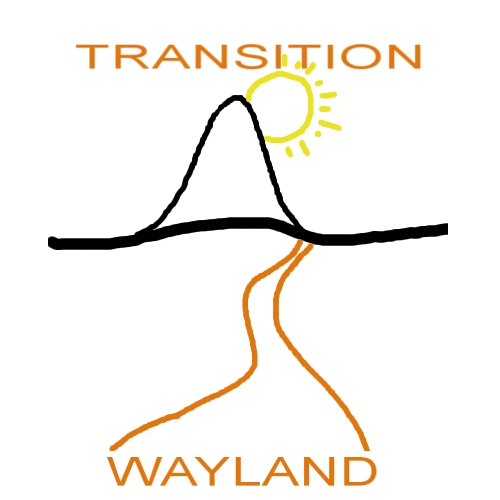
What an opportunity! When I signed on for this, I knew this would be well worth my time. And I was appreciative of the MassCEC for engaging the grassroots in this. Just them, just a solar installer, or a combination of those two, would never have the impact of the grassroots that are already in place.
Putting systems in place for (and before) when they’re needed is one of the goals of Transition work. Cleanly, distributively and locally produced energy is one of those systems. The goal is to enrich Wayland with 100 solar arrays, 100 households that feel the empowerment of being of  producers instead of consumers, 100 households that will model a different energy culture.
Beyond that we are also looking into a Solar Community Garden, for those in our towns whose sites are not conducive for solar due to shading, orientation and other issues. The community building potential of this one is immense.
And beyond that, imagine a local mini-grid… We are laying some of the foundations here for one more element in our town’s resilience.
In the first year of its existence, Transition Wayland has primarily been doing a lot of little things: conversations, small manifestations, some skill building, lots of talking, getting to know our people. Lately we’ve stepped it up, with Earth Day (which attracted 400 visitors), and now with the Solarize program. It feels good to have a larger impact, to make a big change. Big changes in small places, they’ll add up.
Building Your Own Hives or Buying a Kit?
Today we built the last five hive bodies: five medium supers (cf. building the hive boxes and building the frames). I just need to assemble the frames and they’ll go onto the hives and collect honey. Finally, after two dry years, I will have honey, because the bee season and the honey flow so far have been amazing. So, time to see if the decision to build the boxes and to assemble the frames ourselves was a good one. Of course I made the calculation before, but there are always surprises to be reckoned in afterward.
Each of my two hives has:
- screened bottom board: I had these lying around ($0)
- two deeps, built from two 1×12-8 common pine boards ($30)
- 20 wooden frames, bought from  my local bee supplier, unassembled ($22)
- 20 sheets with Duragilt foundation brought from my local bee supplier  ($28)
- two medium supers, built from two 1×8-8 common pine boards ($20)
- 20 wooden frames, bought unassembled from my local bee supplier  ($22)
- 20 Plasticell (plastic and beeswax coating) foundation – unavailable from  my local bee supplier so got it online, so add shipping ($28)
- one  inner cover: bought this from my local bee supplier ($12)
- one telescoping outer cover: bought this from my local bee supplier ($25)
- 2 boxes of 6d 2″ nails ($9)
- gallon of exterior paint (not counting this because the kit I am comparing this to come unpainted)
A similar kit from the local bee supplier (Dadant’s kits, for instance, would be cheaper, but the shipping kills the deal) costs $280.
In the end we saved more than $84 * 2, because we put together some extra boxes and frames, and the bulk-buy of planks, frames and foundation cut the price even more.
Of course this doesn’t reckon the hours DH and I put in, together figuring out box joints and having fun hammering away, but those are priceless anyway. As for the cost of electricity to run the saws and of gasoline to drive to the shops to buy the planks, etc, I doubt they amount to $84. On the whole , I reckon this was a successful venture. I’m happy they’re done, though, and hope they will last many, many years.
One Element at a Time
Two elements in this image, actually. One of which we set in motion a couple of months ago, and one that I just strung.
We had a clothesline until two winters ago, but the trees it was under leafed out so much it stopped being a very good spot: too much shade, too much stuff dirtying the laundry. This is one of those retractable clotheslines, attached to our shed (which still needs its barn doors – why is that when I look at a picture all I see is “things to do”?). Amie and I got all the laundry from one large wash hung up. Amie loves hanging clothes.
Still, I need to rethink it a little. There’s enough line in the roller to add a stretch, but the locking mechanism isn’t very food so the line sags quite a bit. But I want it to be retractable because this side of our yard – the “utilitarian area” with the firewood (off to the right) – gets quite a big of traffic.
In the background you can spot the other element. Our four chicks are two months old now.  Hopefully we’ll have eggs come September. Their coop needs a nest box, siding and paint.
Those green tendrils on the trellis? Hardy kiwi. The two plants are going absolutely wild.
E-Scapes!
It all stacks up!
It’s been hot here. Three days of high 90s in the shade. The animals who are outside are coping. The animals inside, that’s us, less so. The first day was bearable: 75 in/97 out (in shade). I stepped outside around midnight that night and it was still blasting heat, so I didn’t get a chance to flush the house until 5 am. It wasn’t long enough. Day two was 82 in / 99 out and no flushing at all. By now, day three, heat and humidity have accumulated inside and we Amie and I just stay as still as possible. The forecast is that it will break soon. Would be good to have some precipitation, for the garden and for the rain water storage as well. I’m down to three barrels – two are cork dry. Â I can’t wait to get those big water toters.
The garden is thriving. All the beds are full and I even added one bed for the Three Sisters. As for what we”ve been eating, there are peas, finally, only a few, and they won’t last long with this heat. I throw the shoots into salads (they taste like peas). Raspberries are starting to come in, and heaps of chard (which really likes the hoop house heat) as well as spinach and lettuce, and garlic scapes – LOTS of garlic scapes. Today’s harvest was only a quarter of my entire garlic crop. Â I see garlic pesto in my near future. Harvesting these, I must say, is as divine as eating them.
Down the rabbit hole…
Riot for Austerity – March, April and May 2012 – Months 41-43
I can’t believe it’s been three months since I calculated our Riot. But here it is, the Riot for the months of March, April and May of 2012 for the three of us. My summary of our first three years is here. Edson fixed the calculator: all go tither to crunch those numbers!
Gasoline.  Calculated per person. Like I reported in February, the search for transport alternatives ended in a search for people-powered motion. First, find lady’s bike at the town’s transfer station (aka, The Dump). Check. Next, have friend come over and fix it: new tubing, new brakes, new to me steering wheel, some readjustments. Check. Now I’d love a cargo trolley and an electric assist.  I’d charge my assist with the solar panels anyway, making it in effect a solar bike…
In the last three months we used on average
11.34 gallons per person
27.6% of the US National Average
Electricity. This is reckoned per household, not per person. According to our solar meter, we produced 3856 kWh since the system was turned on, and 536 kWh on average over these last three months (you can follow our solar harvest live here). But we’ve been real electricity hogs over here! I’ve had the growing lights on in the basement (sometimes all 9 double TL lights plus the heat mat)  all these months, and over the last two months we had a heat lamp (100 Watts) for our chicks. On top of that, Amie has developed a case of fear of the dark, which necessitates her having her reading light on most of the night (her nightlight is not bright enough). So we have had to pay NStar for the extra we consumed.
536 kwH (solar) + 68 KwH (Nstar) = a whopping 604 KwH on average!
31.5% of the US National Average
Heating Oil and Warm Water. This too is calculated for the entire household, not per person.
13.86 Â gallons of oil
22.5% of the US National Average
Trash. After recycling and composting this usually comes down to mainly food wrappers.
6 lbs. pp per month
4.4%Â of the US National Average
Water. This is calculated per person.
536 gallons pp.
17.9%Â of the US National Average

